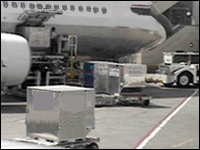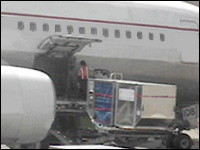Baggage Handling eTool

Ramp Area » Automated Loading and Unloading

Typically, only the largest aircraft use cargo containers to store passenger luggage. These containers are loaded onto the plane using an automated system that is operated by the ramp agent. The automated system will help solve many of the hazards found when loading baggage onto the cargo bin, however, new hazards may exist if there are circumstances where containers need to be manually positioned.
Potential Hazards
-
Reaching to push the container onto the loader can strain the back, shoulders, and arms.
-
Pushing containers that can vary widely in weight can cause strain to many areas of the body.


Possible Solutions
- Educate ramp agents about proper positioning techniques to increase awareness of good work practices.
- Push cargo containers with the help of other workers. Loaded containers should be positioned by at least two people.
-
Avoid pulling the containers; pushing is preferred when manual positioning is necessary.
-
Conduct preventive maintenance inspections on rollers so manual positioning of containers results in as little resistance as possible.



